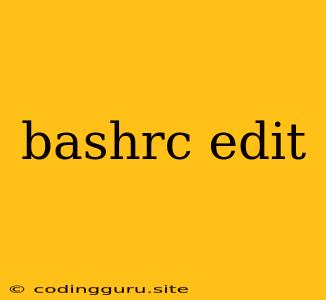Dive into the Realm of .bashrc Customization:
The .bashrc file is a powerful tool at your disposal when navigating the world of Linux and Unix-like operating systems. This hidden gem, located within your home directory, acts as a personalized configuration script for your interactive Bash shell sessions. It's a central hub for commands, aliases, and customizations that tailor your shell environment to your specific needs.
Why Should You Care About .bashrc?
Imagine starting every new terminal session with a personalized greeting, having quick shortcuts for frequently used commands, and enhancing your productivity with custom environment variables. .bashrc makes all of this possible. This file executes every time you launch a new Bash shell, allowing you to automate tasks and customize your shell experience in a way that aligns with your workflow.
The Power of .bashrc
- Command Aliases: Simplify complex or frequently used commands by creating aliases. For instance, you can create an alias
lsto display a colorful and more detailed file listing using thels -l --color=autocommand. - Environment Variables: Define custom variables to streamline your work. You can set paths for your favorite tools, define color schemes for your terminal, or even control the behavior of various applications.
- Interactive Prompt Customization: Craft a custom prompt that displays useful information like your current working directory, git branch status, or the time. This enhances readability and lets you stay informed at a glance.
- Automating Tasks: Run scripts or execute specific commands upon entering a specific directory or starting a new terminal session. This can be incredibly useful for setting up specific environments or running daily tasks.
Essential Tips for Editing .bashrc
-
Back It Up! Before you start editing, always create a backup of your existing
.bashrcfile. This way, you can revert any changes if needed. -
Understanding Syntax: Bash uses specific syntax for defining variables, creating aliases, and running commands. Familiarize yourself with these fundamentals to ensure your edits function correctly.
-
Use
sourceto Apply Changes: After making edits to your.bashrcfile, use thesource .bashrccommand to reload the file and apply the changes to your current shell session. -
Start Small: Don't try to implement everything at once. Begin with simple customizations and gradually expand your
.bashrcfile as you gain confidence. -
Experiment and Learn: The beauty of
.bashrcis that it's a playground for experimentation. Don't be afraid to try different configurations and see what works best for you.
Practical .bashrc Examples
1. Creating a Custom Alias:
alias ll='ls -l --color=auto' # Creates an alias 'll' for the colored 'ls -l' command
2. Setting a Custom Prompt:
PS1='\[\033[01;32m\]\u@\h:\[\033[00m\]\w\$ ' # Sets a green prompt with username, hostname, directory, and dollar sign
3. Defining an Environment Variable:
export EDITOR=vim # Sets the default editor to 'vim'
4. Running a Script upon Directory Entry:
cd /path/to/directory && /path/to/script.sh # Executes 'script.sh' when entering the directory
The Importance of .bashrc
.bashrc isn't just about cosmetic enhancements; it's about streamlining your workflow and making your shell experience more efficient and personalized. By understanding its capabilities and using it strategically, you can elevate your command-line prowess and boost your overall productivity.
Conclusion
The .bashrc file is your personal shell configuration canvas. With a little effort and creativity, you can customize your Bash environment to your liking. From streamlining your daily tasks to enhancing your interactive experience, .bashrc empowers you to command your shell and elevate your command-line mastery.
